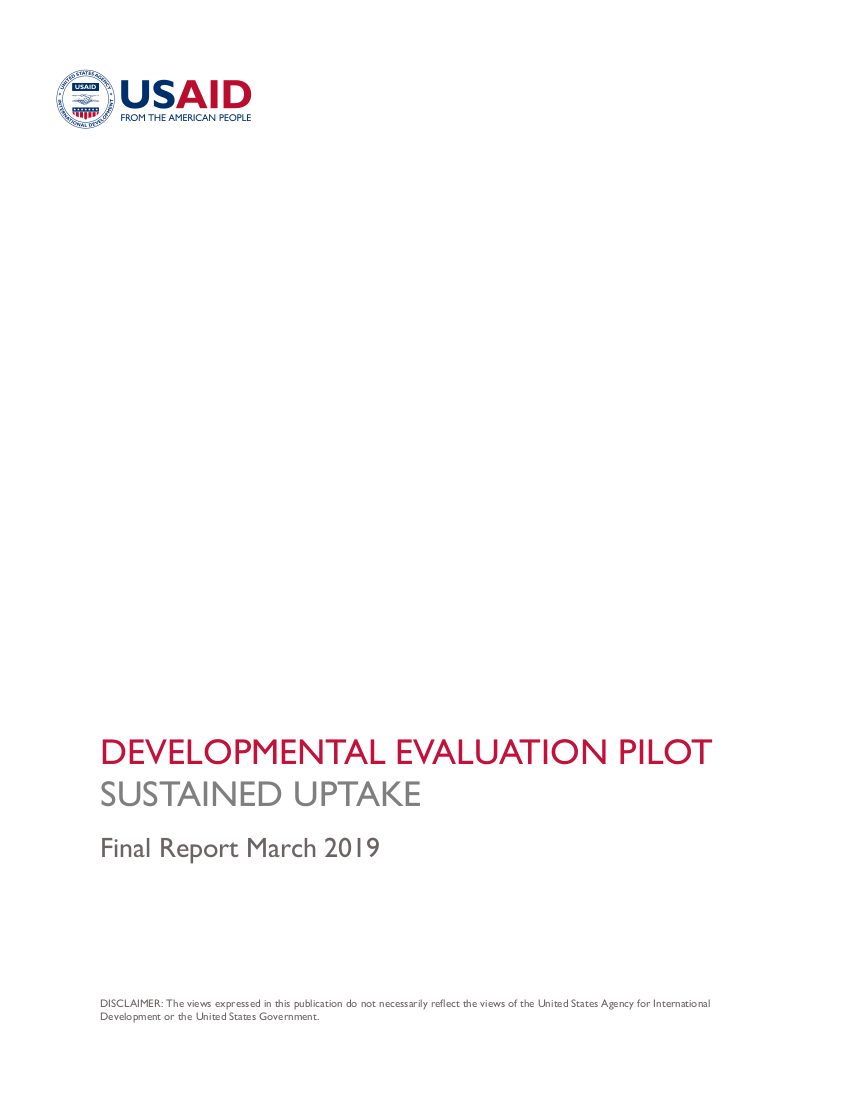- What We Do
- Agriculture and Food Security
- Democracy, Human Rights and Governance
- Economic Growth and Trade
- Education
- Environment and Global Climate Change
- Gender Equality and Women's Empowerment
- Global Health
- Humanitarian Assistance
- Transformation at USAID
- Water and Sanitation
- Working in Crises and Conflict
- U.S. Global Development Lab
Speeches Shim
Developmental Evaluation of the USAID Global Development Lab’s Efforts to Sustain Uptake of Development Approaches
DE Overview
The U.S. Global Development Lab of the United States Agency for International Development (USAID) has evolved its programming related to scaling, adoption, acceleration, and uptake. Between March 2017 and December 2018, the Developmental Evaluation Pilot Activity (DEPA-MERL) supported Lab teams using a developmental evaluation (DE) approach. The Sustained Uptake DE worked with seven teams in the Lab to rigorously collect, analyze, and disseminate learnings on the sustained uptake of innovations within and beyond USAID. The DE worked with teams on capacity building around sustainability and provided timely, on-demand, and use-focused deliverables.
Developmental Evaluation Pilot Sustained Uptake ![]() (pdf - 757k)
(pdf - 757k)
The DE addressed the following questions:
-
What are the conditions and working relationships necessary in the LWPs, the Lab, and its partners to achieve sustained uptake internally (Missions and Bureaus) and externally?
-
How do we determine which current Lab approaches are most effective at sustained uptake? What has been the perceived and real value add of the approaches? What can we learn from Lab uptake models?
-
What are the replicable principles/elements from the different sustained uptake models and how should others apply them to a different context?
-
How does the Lab balance sustained uptake initiatives that are internal versus external? What impact (internal or external) does the Lab value more? Where can the Lab have the most impact?
The Developmental Evaluator employed a variety of techniques, including appreciative inquiry, positive deviance case studies, process tracing, outcome harvesting, and various facilitated work with the DE teams. These evaluative efforts contributed to an iterative database used throughout the DE, resulting in evidence informed by 474 sources and 1,675 unique data points.
Overall, the Sustained Uptake DE provided extensive evaluative and adaptive management support to the Lab, providing them with evidence on effective and efficient models for both internal and external sustained uptake. The DE further improved teams’ capabilities of achieving ecosystem-level outcomes, and provided tools to continue this work moving forward.
Sustained Uptake Pilot Deliverables
-
Uptake Final Report: final report of the Uptake DE, including details on the evaluation methodology, findings, analysis, deliverables, and ongoing engagement process.
-
Uptake Series of Top Learnings: DE deliverables are designed to be use-focused and meet specific needs. The below series of one-pagers were produced through the Sustained Uptake DE to highlight the most significant findings and provide practical guidance on how to achieve sustained uptake.
Other Learnings from the Sustained Uptake DE
The Developmental Evaluation Pilot Activity (DEPA-MERL) is intended to test the effectiveness of a DE approach in achieving effective programming for innovative interventions. All DEPA-MERL pilots incorporate rigorous monitoring and feedback systems on the DE process and utility, with DE learning components led by the William Davidson Institute (WDI) at the University of Michigan. The learning products stemming from these efforts, as well as other cross-pilot learnings incorporating the Sustained Uptake DE, are listed below:
-
A Study of the Sustained Uptake Developmental Evaluation: Using mixed methods such as outcome harvesting, WDI collected data from the Uptake DE to answer questions related to emergent learnings, implementation barriers/enablers, and value added/lost with DE compared to traditional evaluation. The report also includes recommendations for future implementation of DE within USAID.
-
Top Tips for Conducting a Developmental Evaluation at USAID - With USAID-funded DEs, the USAID staff play a critical role as primary stakeholders. By following these eight tips, USAID staff can help manage barriers and promote enablers that impact the implementation of the DE approach.
-
Developmental Evaluation: How Barriers and Enablers Emerge Over Time - This document shares the results from an in-depth qualitative analysis of the barriers and enablers that surfaced during implementation of the Sustained Uptake DE.
-
Sustained Uptake Case Study - This case study showcases why the U.S. Global Development Lab chose to undertake the Sustained Uptake DE, how it was implemented, what value added it brought, and what lessons were learned from it.
-
-
Across Pilot Analysis Report - This report shares findings and lessons learned from across three of DEPA-MERL’s DE pilots, including Uptake, to answer questions related to emergent learnings, implementation barriers/enablers, and value added/lost with DE (in the USAID context) compared to traditional evaluation.
-
Uptake Case Study - This case study provides background on the programming, the DE design and implementation approach, the suitability of DE, and lessons learned for implementation.
What is Developmental Evaluation?
Development Evaluation (DE) is an approach to evaluation that supports the continuous adaptation of development interventions. DE provides evaluative thinking and timely feedback to inform ongoing adaptation as needs, findings, and insights emerge in complex dynamic situations. The DE helps facilitate the process from findings to action in a collaborative process with the DE stakeholders. Learn more about the Developmental Evaluation Pilot Activity (DEPA) and developmental evaluations: https://www.usaid.gov/GlobalDevLab/MERLIN/DEPA-MERL


Comment
Make a general inquiry or suggest an improvement.